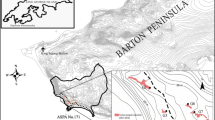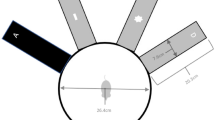Abstract
We document that the cricket, Acheta domesticus, avoids “necromone” chemical cues of death associated with treated surfaces and shelters (i.e., ethanol extracts of cricket bodies, oleic acid or linoleic acid). Initially we tested male responses to male body extract, oleic acid, or linoleic acid associated with shelters. Body extract was more repellent than either oleic or linoleic acid at a dose of 10 body equivalents per shelter. At 15 or 20 body equivalents/shelter extract and oleic acid were similarly repellent but linoleic acid was weaker. We next tested responses of males or females to shelters and surfaces treated with body extracts of males, females, a male-female mixture, or oleic acid. Repellency was evaluated at 1, 16, and 22 h following introduction. Body extracts elicited more immediate aversion than did authentic oleic acid (1 h). Females showed declining aversion with time (1, 16, 22 h), especially with regard to male extract. Alternatively, males showed increasing aversion with time, particularly to female extract. Both sexes showed weak responses to oleic acid at 1 h, but significant aversion at 16 and 22 h. We suggest that females may be less risk aversive as they seek out singing males holding established territories (i.e., mobility makes risk transient). Alternatively, males may respond more strongly to female necromone as this would reduce attraction of females to their territory. Finally, we consider a classic paper that documents a strong cricket repellent associated with tissue-covered perches. We provide new evidence that this repellent was likely an unsaturated fatty acid.


Similar content being viewed by others
References
Abbott KR (2006) Bumblebees avoid flowers containing evidence of past predation events. Can J Zool 84:1240–1247
Akino T, Yamaoka R (1996) Origin of oleic acid corpse recognition signal in the ant, Formica japonica Motschlsky (hymenoptera: Formicidae). Jap J Appl Entomol Zool 40:265–271
Atsumi G, Tajima M, Hadano A, Nakatani Y, Murakami M, Kudo I (1998) Fas-induced arachidonic acid release is mediated by Ca2+-independent phospholipase A2 but not cytosolic phospholipase A2, which undergoes proteolytic inactivation. J Biol Chem 273:13870–13877
Baker RG, Pepper JH, Johnson LH, Hastings E (1960) Estimation of the composition of the cuticular wax of the mormon cricket, Anabrus simplex Hald. J Insect Physiol 5:47–60
Bateman PW, Toms RB (1998) Olfactory intersexual discrimination in an African king cricket (Orthoptera: Mimnermidae). J Insect Behav 11:159–163
Buehlmann C, Graham P, Hansson BS, Knaden M (2014) Desert ants locate food by combining high sensitivity to food odors with extensive crosswind runs. Curr Biol 24:1–5
Cao Y, Pearman AT, Zimmerman GA, McIntyre TM, Prescott SM (2000) Intracellular unesterified arachidonic acid signals apoptosis. PNAS 97:11280–11285
Chouvenc T, Robert A, Semon E, Bordereau C (2012) Burial behaviour by dealates of the termite Pseudacanthotermes spiniger (Termitidae, Macrotermitinae) induced by chemical signals from termite corpses. Insect Soc 59:119–125
Cripps C, Blomquist GJ, de Renobales M (1986) De novo biosynthesis of linoleic acid in insects. Biochim Biophys Acta 876:572–580
Diez L, Lejeune P, Detrain C (2014) Keep the nest clean: survival advantages of corpse removal in ants. Biol Lett. doi:10.1098/rsbl.2014.0306
Diez L, Moquet L, Detrain C (2013) Post-mortem changes in chemical profile and their influence on corpse removal in ants. J Chem Ecol 39:1424–1432
Diez L, Urbain L, Lejeune P, Detrain C (2015) Emergency measures: adaptive response to pathogen intrusion in the ant nest. Behav Process 116:80–86
Golebiowski M, Cerkowniak M, Bogus MI, Włoka E, Dawgul M, Kamysz W, Stepnowski P (2013) Free fatty acids in the cuticular and internal lipids of Calliphora vomitoria and their antimicrobial activity. J Insect Physiol 59:416–429
Grapes M, Whiting P, Dinan L (1989) Fatty acid and lipid analysis of the house cricket, Acheta domesticus. Insect Biochem 19(8):767–774
Green PWC (2011) Insect-derived compounds affect the behaviour of Liposcelis bostrychophila: effects of combination and structure. J Stored Prod Res 47:262–266
Gutierrez AC, Biowski MG, Pennisi M, Peterson G, Garcia JJ, Manfrino RG, Lastra CCL (2015) Cuticle fatty acid composition and differential susceptibility of three species of cockroaches to the entomopathogenic fungi Metarhizium anisopliae (Ascomycota, Hypocreales). J Econ Entomol. doi:10.1093/jee/tou096
Hack MA (1998) The energetics of male mating strategies in field crickets (Orthoptera: Gryllinae: Gryllidae). J Insect Behav 11:853–867
Hans H, Lone A, Aksenov V, Rollo CD (2015) Impacts of metformin and aspirin on life history features and longevity of crickets: trade-offs versus cost-free life extension? Age 37:31. doi:10.1007/s11357-015-9769-x
Hedrick AV, Dill LM (1993) Mate choice by female crickets is influenced by predation risk. Anim Behav 46:193–196
Hoefler CD, Durso LC, McIntyre KD (2012) Chemical-mediated predator avoidance in the European house cricket (Acheta domesticus) is modulated by predator diet. Ethology 118:431–437
Kortet R, Hedrick A (2004) Detection of the spider predator, Hololena nedra by naïve juvenile field crickets (Gryllus integer) using indirect cues. Behaviour 141:1189–1196
Kortet R, Hedrick A (2005) The scent of dominance: female field crickets use odour to predict the outcome of male competition. Behav Ecol Sociobiol 59:77. doi:10.1007/s00265-005-0011-1
Lee SH, Meng XW, Flatten KS, Loegering DA, Kaufmann SH (2013) Phosphatidylserine exposure during apoptosis reflects bidirectional trafficking between plasma membrane and cytoplasm. Cell Death Differ 20:64–76
Lyn JC, Naikkhwah W, Aksenov V, Rollo CD (2011) Influence of two methods of dietary restriction on life history features and aging of the cricket Acheta domesticus. Age 33:509–522
Lyn J, Aksenov V, LeBlanc Z, Rollo CD (2012) Life history features and aging rates: insights from intra-specific patterns in the cricket Acheta domesticus. Evol Biol 39:371–387
Maák I, Markó B, Eros K, Babik H, Slipinski P, Czechowski W (2014) Cues or meaningless objects? Differential responses of the ant Formica cinerea to corpses of competitors and enslavers. Anim Behav 91:53–59
Martin C, Chevrot M, Poirier H, Passilly-Degrace P, Niot I, Besnard P (2011) CD36 as a lipid sensor. Physiol Behav 105:36–42
Martin S, Drijfhout F (2009) A review of ant cuticular hydrocarbons. J Chem Ecol 35:1151–1161
McFarlane JE (1984) Repellent effect of volatile fatty acids of frass on larvae of the German cockroach, Blattella germanica (L.) (Dictyoptera:Blattellidae). J Chem Ecol 10:1617–1622
McFarlane JE, Alli I (1985) The volatile fatty acids of the frass of certain omnivorous and phytophagous insects. J Chem Ecol 11:59–63
McFarlane JE, Alli I (1986) Aggregation of larvae of Blattella germanica (L.) by lactic acid present in the excreta. J Chem Ecol 12:1369–1375
McFarlane JE, Alli I (1987) The effect of lactic acid and the volatile fatty acids on the aggregation behavior of Periplaneta americana (L.) Comp Biochem Physiol 86C:45–47
McFarlane JE, Alli I, Steeves E (1984) Studies on the group effect in Acheta domesticus (L.) using artificial diets. J Insect Physiol 30:103–107
McFarlane JE, Steeves E, Alli I (1983) Aggregation of larvae of the house cricket, Acheta domesticus (L.), by propionic acid present in the excreta. J Chem Ecol 9:1307–1315
Meunier J (2015) Social immunity and the evolution of group living in insects. Philos Trans R Soc B 370. doi:10.1098/rstb.2014.0102
Neoh K-B, Yeap B-K, Tsunoda K, Yoshimura T, Lee C-Y (2012) Do termites avoid carcasses? Behavioral responses depend on the nature of the carcasses. PLoS One 7(4):e36375. doi:10.1371/journal.pone.0036375
Nilsson E, Bengtsson G (2004a) Death odour changes movement pattern of a Collembola. Oikos 104:509–517
Nilsson E, Bengtsson G (2004b) Endogenous free fatty acids repel and attract Collembola. J Chem Ecol 30:1431–1443
Raksakantong P, Meeso N, Kubola J, Siriamornpun S (2010) Fatty acids and proximate composition of eight Thai edible terricolous insects. Food Res Int 43:350–355
Renucci M, Tirard A, Provost E (2011) Complex undertaking behavior in Temnothorax lichtensteini ant colonies: from corpse-burying behavior to necrophoric behavior. Insect Soc 58:9–16
Richard FJ, Aubert A, Grozinger C (2008) Modulation of social interactions by immune stimulation in honey bee, Apis mellifera, workers. BMC Biol 6:50. doi:10.1186/1741-7007-6-50
Riddervold MH, Tittiger C, Blomquist GJ, Borgeson CE (2002) Biochemical and molecular characterization of house cricket (Acheta domesticus, Orthoptera: Gryllidae) Δ9 desaturase. Insect Biochem Mol Biol 32:1731–1740
Rollo CD (2007) Multidisciplinary aspects of regulatory systems relevant to multiple stressors: aging, xenobiotics and radiation. In: C. Mothersill, I. Mosse and C. Seymour (Eds.). Multiple stressors: a challenge for the future. Springer (NATO science), pp 185–224
Rollo CD, Borden JH, Casey I (1995) Endogenously produced repellent from American cockroach (Blattaria: Blattidae): function in death recognition. Environ Entomol 24:116–124
Rollo CD, Czyewska E, Borden JH (1994) Fatty acid necromones for cockroaches. Naturwissenschaften 81:400–410
Scherkenbeck J, Nentwig G, Justus K, Lenx J, Gondol D, Wendler G, Dambach M, Nischk F, Graef C (1999) Aggregation agents in German cockroach Blattella germanica: examination of efficacy. J Chem Ecol 25:1105–1119
Sexton OI, Hess EH (1968) A pheromone-like dispersant affecting the local distribution of the European house cricket, Acheta domestica. Biol Bull 134:490–502
Sitvarin MI, Romanchek C, Rypstra AI (2015) Nonconsumptive predator–prey interactions: sensitivity of the detritivore Sinella curviseta (Collembola: Entomobryidae) to cues of predation risk from the spider Pardosa milvina (Araneae: Lycosidae). Environ Entomol 44:349–355
Stout JC, Goulson D, Allen D (1998) Repellent scent-marking of flowers by a guild of foraging bumblebees (Bombus sp.) Behav Ecol Sociobiol 43:317–326
Sun Q, Zhou X (2013) Corpse management in social insects. Int J Biol Sci 9:313–321
Tang DG, La E, Kern J, Kehrer JP (2002) Fatty acid oxidation and signaling in apoptosis. Biol Chem 383:425–442
Tyurin VA, Balasubramanian K, Winnica D, Tyurina YY, Vikulina AS, He RR, Kapralov AA, Macphee CH, Kagan VE (2014) Oxidatively modified phosphatidylserines on the surface of apoptotic cells are essential phagocytic ‘eat-me’ signals: cleavage and inhibition of phagocytosis by Lp-PLA2. Cell Death Differ 21:825–835
Walker KA, Jones TH, Fell RD (1993) Pheromonal basis of aggregation in European earwig, Forficula auricularia L. (Dermaptera: Forficulidae). J Chem Ecol 19:2029–2037
Wilson EO, Durlach NI, Roth LM (1958) Chemical releasers of necrophoric behavior in ants. Psyche 65:108–114
Yang LF, Siriamornpun S, Li D (2006) Polyunsaturated fatty acid content of edible insects in Thailand. J Food Lipids 13:277–285
Yao M, Rosenfeld J, Attridge S, Sidhu S, Aksenov V, Rollo CD (2009) The ancient chemistry of avoiding risks of predations and disease. Evol Biol 36:267–281
Acknowledgements
This research was supported by a combination of private funds and a grant to C. David Rollo from the Natural Sciences and Engineering Research Council of Canada (NSERC). The authors recognize a major contribution by Janet Yu to the preliminary bioassays. We thank Akshay Pandey and Eston Chen for their assistance with sex-specific assays.
Author information
Authors and Affiliations
Corresponding author
Rights and permissions
About this article
Cite this article
Aksenov, V., David Rollo, C. Necromone Death Cues and Risk Avoidance by the Cricket Acheta domesticus: Effects of Sex and Duration of Exposure. J Insect Behav 30, 259–272 (2017). https://doi.org/10.1007/s10905-017-9612-6
Revised:
Accepted:
Published:
Issue Date:
DOI: https://doi.org/10.1007/s10905-017-9612-6




